AACtual Therapy: Chaining in AAC
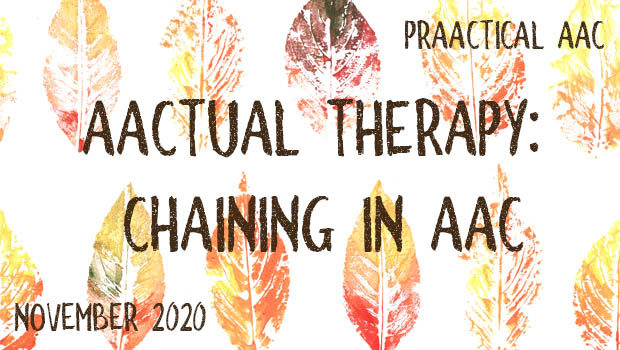
 Effective AAC interventionists know the importance of being skilled in using a number of different strategies and techniques for building language. So we’re pleased that SLPs Kate Grandbois and Amy Wonkka are making a return visit to talk more about their favorite therapy strategies and how to apply them to AAC skill-building. In today’s post, they discuss the use of chaining in teaching individuals with AAC needs.
Effective AAC interventionists know the importance of being skilled in using a number of different strategies and techniques for building language. So we’re pleased that SLPs Kate Grandbois and Amy Wonkka are making a return visit to talk more about their favorite therapy strategies and how to apply them to AAC skill-building. In today’s post, they discuss the use of chaining in teaching individuals with AAC needs.
You can see their previous post here. Also, don’t miss the link to their podcast at the end, especially if you are interested in earning CEUs for listening.
::::::::::::::::::::::::::::::::::::::::::::::::::::::::::::::::::::::::::::::::::::::::::
Bringing it all Together, Episode 2: Chaining in AAC
As we mentioned in our previous article, most SLPs have come across popular AAC interventions, like aided language modeling. But there are other interventions, like chaining, that don’t quite get the time in the limelight that they deserve. Chaining is one of these interventions. Chaining interventions in the AAC world might be best known for their role in the PECS ® protocol, however, chaining is commonly used throughout AAC interventions without being named.
We are excited to present to you the second episode in our series of Bringing it All Together: Chaining in AAC. Our goal is that you read this article and leave feeling like chaining is the friend you didn’t know you had but was there supporting you all along.
Chaining
First, what is it?
Before we get into the concept of chaining in AAC, let’s take a look at what chaining is by itself. Believe it or not, chaining comes to us from the world of ABA (but don’t let that put you off – it’s a great technique!). By definition, “a behavior chain is a linked sequence of responses leading to a terminal outcome” (Copper, Heron, & Heward, 2020, p. 558). As an example, if the “terminal outcome” was a peanut butter and jelly sandwich, then the “linked sequence of responses” might be: open the peanut butter jar, open the jelly jar, pick up the knife, scoop peanut butter and smear on the bread, scoop jelly and smear on the bread, etc. (you get the picture). Each specific action is linked together in a sequence to create a final result, and the final result is reinforcing. This means that the final result (maybe eating the PB & J) makes the behavior chain more likely to occur in sequence in the future.
So how does this relate to AAC? Well, behavior chains happen in communication all the time. We chain different words together to have a specific outcome or impact when we communicate. We chain our oral motor movements together in specific sequences to produce speech productions. Mapping this onto AAC isn’t that different – it is still language and communication. Non-speaking persons chain symbols together to communicate the same way speaking persons do. Non-speaking persons link actions together to access language similar to the way speaking persons chain oral motor movements to produce speech. The “terminal outcome” is the production of language or communication itself. The overall purpose of a behavior chain is to produce reinforcement, and in communication that comes in many forms: conversing with a friend, making a social connection, gaining access to information, or communicating wants and needs. Like any other form of intervention, chaining can be used for a myriad of reinforcing outcomes related to communication.
So now that we know what a behavior chain is, it’s time to dissect the act of teaching someone to link different responses for that terminal outcome or chaining. There are three types of chaining that come up often in the world of AAC: forward chaining, backward chaining, and total task chaining. (Technically there are four types of chaining procedures, but we aren’t going to cover them all here. To read more about other types of chaining we refer our readers to the publication by Cooper, Howard, & Heron, 2020. You can also email us anytime!).
Forward Chaining in AAC
In forward chaining the steps in a sequence are taught in their naturally occurring order, and at first, reinforcement is given for completing just the first step in the chain. Let’s use an example specifically related to AAC. Let’s say you are working on increasing expressive vocabulary and your client LOVES vehicles. You decide to target the word “drive.” Depending on what system you are using the icon sequence could look like this (this particular example uses Minspeak symbols).
Your goal is for your client to produce all three icons in this specific sequence to produce the target word. To teach this chain of actions using a forward chaining technique we would first teach selecting the first icon in the chain.
Once your client selects this icon you zoom the cars around the room. In other words, you provide the reinforcement for selecting only the first icon in the sequence. Next, you teach them to select the first and second icon in the sequence together.
Once they produce the two icons you zoom the cars around the room, delivering reinforcement after both icons are selected. Finally, you teach them to select the third and final icon in the sequence after the selection of the first two.
Once all three icons are selected in sequence the cars are zoomed around the room. The chain is taught forwards. If you have a longer, more complex chain, this continues all the way until eventually, your student is completing all the steps in the chain independently.
One of the biggest pros to using forward chaining is that the learner has repeated practice with the first step as later steps are added in. You also have an opportunity to keep them engaged by delivering reinforcement (the fun part) at the beginning of the chain, which can be particularly helpful for clients who might be easily frustrated or have competing sensory or attention needs. One of the biggest drawbacks of forward chaining is that teaching one skill at a time can mean slower progress, and it might feel a little unnatural to end the activity after the first step in the sequence. For example, it might feel odd to zoom cars around the room after an individual selects the icon “ride.”
Backward Chaining in AAC
In backwards chaining, the steps in a sequence are taught with the last step first. To continue with our example, let’s say the last step in the sequence is producing the word “drive.” In a backward chaining procedure, you would select the first icons in the sequence for the student and then provide support as needed for the final step.
Once this step was mastered you would teach the student to complete the second to last icon together with the final icon.
This continues until eventually the student begins the chain with the first step and can complete all the steps independently. The chain is taught backwards. One of the biggest pros to using backward chaining is accessing reinforcement at a naturally occurring time (i.e. the student produces “drive” and is presented with zooming cars). The drawbacks are similar to using forward chaining – teaching one step at a time could mean slow progression, and your learner might need to tolerate prompting and/or a slight delay to the fun stuff (i.e. tolerate selecting multiple icons before zooming cars around the room).
Total Task Chaining in AAC
Finally, in total task chaining, you teach all the steps in a sequence together with varied supports for each step depending on the level of client independence. In this example, this means that you would start with the first icon in the sequence (selecting “ride”) and within the same session move onto the second icon (“DRIVE”), and final icon (“drive”), providing support at each step as needed.
In total task chaining reinforcement is delivered when the chain is complete. One of the biggest pros to using total task chaining is that the learner has an opportunity to practice the whole routine. The drawbacks are that there is more room for error (for both the client and the therapist), overall there are more steps for the student to master simultaneously which might require tolerating prompts or support.
How do I use chaining? What does the intervention look like?
The first step to implementing a chaining procedure is to identify all the steps in a chain. This is called performing a task analysis, or a TA for short. While this might seem somewhat obvious, it’s actually a crucial step in the success of any chaining procedure. TA’s can be used for a variety of things outside of the sequences commonly taught in special education. They can be used for complex routines or tasks that have a much narrower scope (Adams, Rogers, and Fisk, 2013). One thing to consider is your own personal level of familiarity with the task. For example, you are more than likely familiar with the steps involved to make a peanut butter and jelly sandwich than you are to the complex set of sequences required to run a piece of complex machinery. Let’s think about how a TA might be relevant to AAC: are you that familiar with the eye gaze system that your student was just prescribed? Do you have a level of mastery with the communication software that your student is using? Your familiarity with the task is crucial in identifying all the steps needed to complete the task. If you want your student to produce the target “silly” on their communication device, you must be familiar with the steps involved to successfully produce that language. In AAC this might mean the location of an icon, a motor sequence to access the icon, or a more complex set of sensory, motor, and iconicity interactions.
Once you have familiarized yourself with the task (or found someone who is familiar), you can begin by defining the overarching sequence you want to teach and complete your TA. Then, you will need to decide whether or not to use forward chaining, backward chaining, or total task chaining. What the intervention looks like will depend a lot on which type of chaining you use. According to literature, one kind of chaining isn’t necessarily better than the other, but there may be situations that are better suited to one kind of chaining over the other (Slocum and Tiger, 2011).
What should I do next?
When you’ve completed your TA and you are ready to begin your intervention, you will want to consider a variety of client variables as well as what is involved in the chain itself prior to deciding what kind of chaining strategy to use. It may feel like a daunting task, but if you break it down into smaller steps it is very doable.
Step 1: Plan it
Consider all the steps in the chain very carefully and write your task analysis. Be mindful of complexity, and frustration levels on the part of the communicator and communication partners. Consider who will be implementing your chaining intervention and the level of detail needed for it to be “just right.” Consider what it will take for the strategy to be implemented correctly but not feel overwhelming. Finally, consider the environment(s) within which the skill will be taught and used. If you are writing a TA for a very complex task, consider if it should really be broken apart into a greater number of less complex TAs. Once you’ve considered some important variables – begin drafting the steps!
Action Item: Write it down. Depending upon your familiarity with drafting TAs, and/or the complexity of the TA you are writing, this may take a few drafts to get just right. Keep at it! For some tasks, you can think about all of the steps involved, write them down, and move on to Step 2. For others, it might be helpful to watch somebody else do the task (either live or a video), or to write down the steps as you do the steps yourself. You also might be able to find a ready-made TA available (e.g., are you teaching your client how to program their device – check the vendor’s website for step-by-step TAs for many operational skills as well as video tutorials demonstrating the steps in action). You might find our TA Planning Form helpful.
Step 2: Try it out – edit as needed
How many times have we written a TA and realized it was missing an important step – or a larger step needed to be further broken down into mini-steps? Let’s just say more than once. Chances are you might need to revise your initial TA. This is particularly true if you are planning to share it with others and ask them to implement a chaining intervention using these steps.
Action Item: Test it. Revise it if needed. Use the TA you just wrote for the sequence and make sure it is adequate in terms of thoroughness and detail. Revise it if you need to, and then try it out again. Once you feel comfortable with the TA – if your chaining intervention will involve other communication partners, ask them to try it as well. Did it make as much sense to them as it did to you? If not, revise it until the TA is easily understood by everybody who will be expected to use it.
Step 3: Assign a chaining strategy
Depending upon the ultimate target skill, the environments in which it will be used, and the communicator’s unique learning style, one approach is likely to be preferred over another. Consult with relevant stakeholders and make a determination about which approach you will use. Share that information with all communication partners who will be asked to implement the chaining approach as an intervention. Consider drafting a plan that includes a description of the chaining process (we like including a brief why we came to that decision, and why the target skill is important), the steps in the TA, and the criteria for moving on to the next step in the sequence.
Action Item: Document the plan. Once you have drafted your TA and selected your chaining approach, it is time to document the plan in one cohesive place. We often use a data sheet type format, because then we have a data sheet ready to go and share with others! We’ve provided two visual example below. Consider developing your own, or modify our example here.
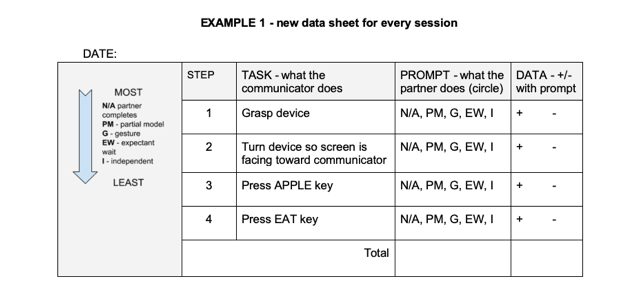
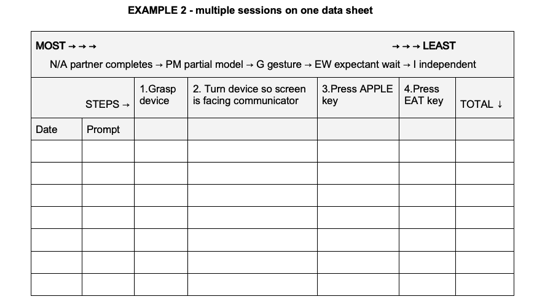
Step 4: Implement and solicit ongoing feedback
Share your plan with all relevant communication partners and other stakeholders. Emphasize that you are interested in hearing feedback – from the communicator, communication partners, and others – in order to make revisions when necessary. If your TA and chaining procedure is somewhat complex, find a time to provide training or other supports which could be accessed asynchronously – such as pictures, written text, and/or videos.
Action Item: Share it. Share all of the information, and ideally model how the chaining strategy should be used. Role play with communication partners, with each partner having an opportunity to implement the chaining strategy and receive support from another partner through the use of the chaining strategy.
To learn more about chaining and task analyses, we encourage you to check out the references listed below. Overall, chaining interventions can help us break apart complex tasks and teach the component parts of a skill in a way that helps communicators and partners to be successful.
References
Adams, A. E., Rogers, W. A., & Fisk, A. D. (2013). Skill components of task analysis. Instructional Science, 41(6), 1009-1046. doi:10.1007/s11251-013-9270-9
Cooper, J., Heron, T. & Heward, W., 2020. Applied Behavior Analysis. 3rd Ed. Upper Saddle River, Nj: Pearson
Slocum, S. K., & Tiger, J. H. (2011). An Assessment Of The Efficiency Of And Child Preference For Forward And Backward Chaining. Journal of Applied Behavior Analysis, 44(4), 793-805. doi:10.1901/jaba.2011.44-793
About the Guest Authors
Amy Wonkka: Amy has worked as a speech-language pathologist in the Northeast and Midwest. Prior to becoming an SLP she worked for several years as a 1:1 paraprofessional and home service provider for individuals with complex communication needs. She has experience in home-based, public school, nonpublic school, and outpatient environments. Amy’s clinical interests include augmentative and alternative communication (AAC), autism and other related needs, typical language development, motor speech, phonology, data collection, collaboration, coaching, and communication partner training and support.
Kate Grandbois: Kate is a dually certified SLP / BCBA with 13 years of clinical experience working in private practice, outpatient clinics, outpatient hospital settings, and consulting to private schools and legal teams. She specializes in augmentative alternative communication, autism and associated disorders, language development, and integrating AAC into the educational/vocational programming of persons with behavioral needs. Her private practice, Grandbois Therapy + Consulting, LLC, focuses on multidisciplinary treatment, collaboration, and mentorship. She has served as an advisory board member for the HP Hacking Autism Initiative, as adjunct faculty at Northeastern University, and is the former president and co-founder of The Speech and Language Network, Inc.
Check SLP Nerdcast for an audio version of this episode that can be used for 1 ASHA CMH (equal to .1 ASHA CEU).
References
Adams, A. E., Rogers, W. A., & Fisk, A. D. (2013). Skill components of task analysis. Instructional Science, 41(6), 1009-1046. doi:10.1007/s11251-013-9270-9
Cooper, J., Heron, T. & Heward, W., 2020. Applied Behavior Analysis. 3rd Ed. Upper Saddle River, Nj: Pearson
Slocum, S. K., & Tiger, J. H. (2011). An Assessment Of The Efficiency Of And Child Preference For Forward And Backward Chaining. Journal of Applied Behavior Analysis, 44(4), 793-805. doi:10.1901/jaba.2011.44-793
Filed under: Featured Posts, PrAACtical Thinking
Tagged With: Intervention & Instructional Strategies, Language Intervention/Therapy
This post was written by Carole Zangari

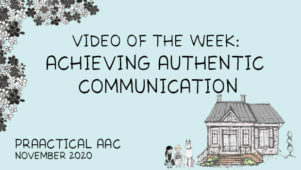
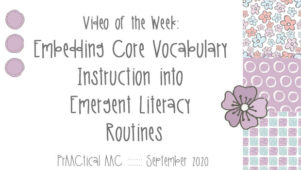

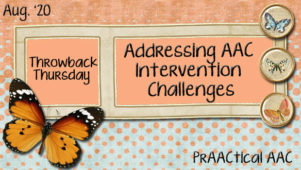
1 Comment
I thoroughly enjoyed reading this article. You have explained chaining procedues so clearly. SLPs can benefit from learning more about ABA strategies to better serve our clients with complex communication needs. Thank you for this post!